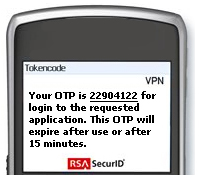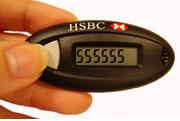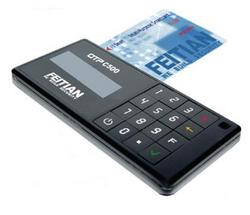As we had discussed before, one-factor authentication is not sufficient in order to have good security. Especially when we talk about sensitive transaction such as banking transactions, it is not secure anymore today if it were done only using username and static password.
Two-factor has to come into the IT security field to ensure that the correct person is authenticated. The items below are the five most popular methods used for any two-factor authentication.
1. Mobile OTP

Mobile One-Time Password (OTP)
A very popular and cost saving method is to use a SMS gateway and send OTP (one-time password) to a mobile phone user. This method is used widely simply because everyone has a mobile phone today which means everyone can use two-factor authentication as long as the host of the application willing to invest and provide this service.
2. OTP Token

One-Time Password (OTP) Token
OTP token works more or less the same as the Mobile OTP. The difference is that this is a separate device and the OTP can be generated immediately instead of waiting for the SMS gateway to send. As a result, it is more reliable than the Mobile OTP but additional cost needed to have this device.
3. PKI USB Token

Public Key Infrastructure (PKI) Token
PKI USB Token offers the second best security in the market by beating off man in the middle attack such as phishing attack. However, PKI implementation needs an infrastructure where it is going to be costly. Due to the cost matter, PKI is not well known in certain countries as people will go for OTP to have the balance of security and investment cost.
4. EMV Cap OTP with Signature

Europay, MasterCard and VISA (EMV) Cap One-Time Password (OTP) with Signature
EMV Cap OTP offers the best security around as it not only beats off the man in the middle attack, but also the man in the browser attack. This is simply because the user needs to sign the transaction using the EMV card reader instead of the web browser. As a result, the Trojan of the man in the browser will no longer work. The drawback is that, signing with transaction device can be a tedious thing to do. The user needs to enter correctly the recipient’s account number and the amount in order to perform the transaction successfully.
5. Out of Band Transaction Detail Verification

Out of Band
This method provides the best security similar to the above and solves as well the weakness of the EMV Cap OTP. What this method does is to send the user the details of the transaction such as the recipient’s account number, amount and the OTP code via non-internet channel such as voice call or SMS. The user will verify those details given and confirm the transaction by submitting the OTP code into the web browser. This gives great security but not anything more after that. Unlike PKI, that piece of digital certificate can do not only authentication signing, but also document signing, PDF signing or even data encryption.
Nothing is perfect in this world where everything has its good and bad. You have to clearly define what you want and I’m sure you can find the device that is suitable to you.






